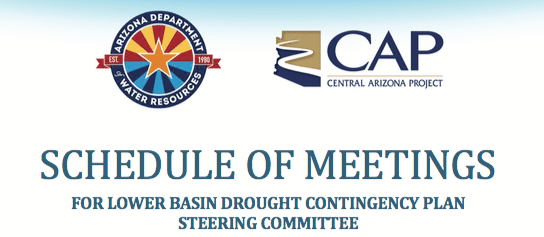1. LANDSCAPE PLANTS FOR THE ARIZONA DESERT BOOKLET IS A GUIDE TO GROWING – Tucson Water and the Arizona Municipal Water Users Association (AMWUA) offer Landscape Plants for the Arizona Desert, a guide to help residents create an attractive, water-efficient landscape. Plants listed include trees, shrubs, groundcovers, vines, cacti, and more. The plants featured were selected by landscape professionals and are drought hardy, tolerant of heat and cold, and adapted to our soil conditions. The guide is available online. For a free booklet, send an email to [email protected] with your name and postal address. Landscape Plants for the Arizona Desert: http://bit.ly/2xwaTkV Tucson Water: http://1.usa.gov/1kA18Hj Arizona Municipal Water Users Association: http://bit.ly/2kBsFMH Basin Drought Committee

2. Lower Basin Drought Contingency Plan Steering Committee Meetings:
Meeting # 6: October 10, 1-4 pm
Meeting # 7 October 25, 1-4 pm
Meeting # 8 November 8, 1-4 pm
Meeting # 9 November 29, 1-4 pm
All meetings are at the CAWCD Headquarters located at 23636 N. 7th Street, Phoenix 85024.
3. Green Building Lecture Series
Green Building series kicks off with “The Circular Economy: Reduce, Reuse, Recycle, Reconsider and Re-imagine”

Date: Thursday, Oct. 4
Time: 7 – 8:30 p.m.
Location: Scottsdale Granite Reef Senior Center, 1700 N. Granite Reef Road (northwest corner of McDowell and Granite Reef, behind the convenience store) There is wisdom in the old saying “one man’s trash is another man’s treasure.” What if instead of burying our trash in a landfill, we recirculated it back into the economy? What if we began to regard “waste” as a “resource?”
Scottsdale’s Green Building Lecture Series kicks off its new season with a discussion on the reuse and recovery of materials and products we use every day. In a traditional linear economy, products are made, used and disposed of in the landfill. In a circular economy, resources are kept in use for as long as possible to extract maximum value, then recovered to regenerate new materials. Circular economies divert waste from landfills, reduce environmental impacts, conserve energy and water, save money and create jobs.

Speakers:
John Trujillo, principal of Circonomy Solutions, will lead the discussion. As former city of Phoenix Public Works director, he reinvented the city’s waste collection and recycling programs to dramatically move the city toward zero-waste. John will share business and public sector efforts to recover material resources for reuse and regeneration in an economically viable and environmentally compatible way.
4. Mail Carriers, Newspaper Delivery People, And Vetrinarians Might Have A Problem If They Had Cynohobia. What is the phobia? Answer at the end of the newsletter.
5. OSHA 8 Hour Refresher. An 8 hour OSHA refresher class will be held on October 8, 2018 Columbus Day, in Glendale.
If you are interested in attending the class, contact D. Salzler at (623) 930-8197 or at [email protected]. Cost is $80 per student. A light breakfast with coffee is provided and lunch is provided at no extra cost.
6. Breakfast With a Dose of Roundup? Weed Killer in $289 Million Cancer Verdict Found in Oat Cereal and Granola Bars
WEDNESDAY, AUGUST 15, 2018 By Alexis Temkin, Ph.D., Toxicologist
Popular oat cereals, oatmeal, granola and snack bars come with a hefty dose of the weed-killing poison in Roundup, according to independent laboratory tests commissioned by EWG.

Glyphosate, an herbicide linked to cancer by CA state scientists and the World Health Organization, was found in all but two of 45 samples of products made with conventionally grown oats. Almost three-fourths of those samples had glyphosate levels higher than what EWG scientists consider protective of children’s health with an adequate margin of safety. About onethird of 16 samples made with organically grown oats also had glyphosate, all at levels well below EWG’s health benchmark.
Glyphosate is the active ingredient in Roundup, the Monsanto weed killer that is the most heavily used pesticide in the U.S. Last week, a California jury ordered Monsanto to pay $289 million in damages to a man dying of cancer, which he says was caused by his repeated exposure to large quantities of Roundup and other glyphosate-based weed killers while working as a school groundskeeper. EWG tested more than a dozen brands of oat-based foods to give Americans information about dietary exposures that government regulators are keeping secret. In April, internal emails obtained by the nonprofit US Right to Know revealed that the Food and Drug Administration has been testing food for glyphosate for two years and has found “a fair amount,” but the FDA has not released its findings.



x. Join Us For Our 10th Annual
Santa Cruz River Research Days
What We Do in the Santa Cruz:
The Santa Cruz River Initiative is focused on reconnecting communities with the river, retaining stretches with flowing water, and restoring watershed conditions. Our overall goal is to invest in water for the environment and communities along the Santa Cruz River.
What are the Santa Cruz River Research Days?
This FREE annual event is a venue for learning about research and conservation efforts that pertain to the natural and cultural resources along the Santa Cruz River. Our goals for this event are to trigger new research questions, promote networking, catalyze new collaborative projects and foster awareness of each other’s research and conservation efforts. Learn more and find updates on October 30, 2018 at 8:a.m. to October 31 at 4:00 p.m at Pima Communnity College, Desert Vista Campus, 5901 S Calle Sant Cruz Community Room, Tucson, AZ 85709.
Contact Claire Zugmeyer at the Sonoran Institute 520- 290-0828 ext 1143 or [email protected].
In honor of our tenth anniversary, we will build a collaborative research agenda for the river. We invite you to join other scientists, river landowners, resource manager, and other decision makers. Together, we will create a snapshot of research priorities, answer questions such as, what information gaps do we have, how can we better communicate our findings, and how can we form great partnerships? Help start the conversation by registering now at
Additional highlights:
: Updates on current research, including the surprise discovery of the Gila Topminnow’s return and the results of several community perspective surveys throughout the watershed.
: A celebration of our accomplishments over 10 yers of Santa Cruz River Research Days
: Field trip to a watershed restoration site, and more.
To Register:
http://events.r20.constantcontact.com/register/event?oeidk=a07eezw0ht0ab24dfe3&llr=vfu4x hcab&showPage=true
No 4 Answer: Fear of Dogs
